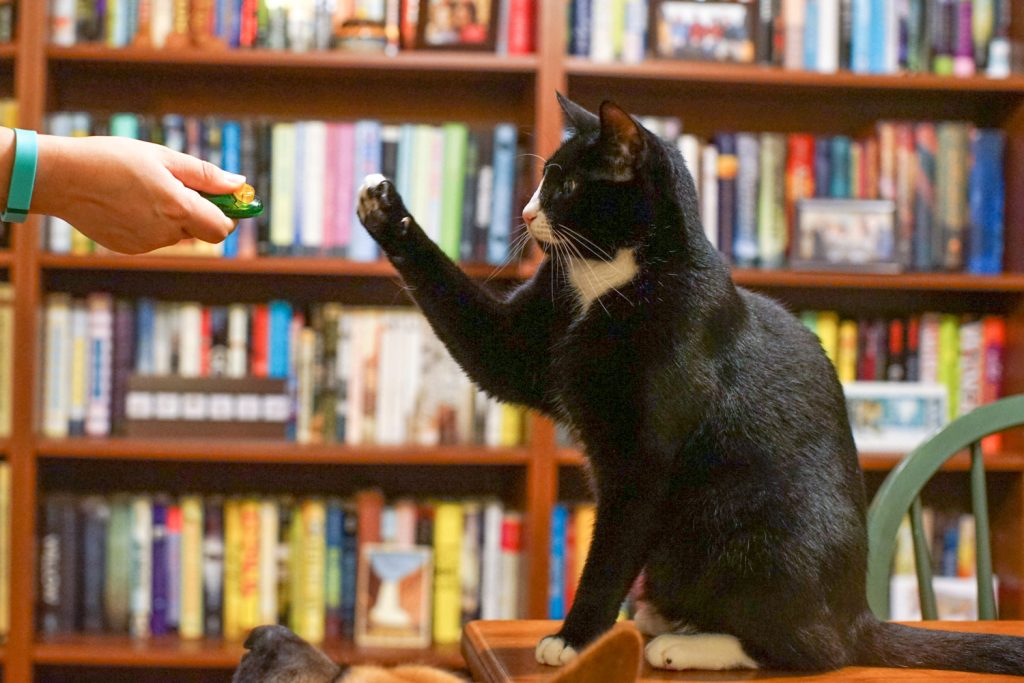Positive Reinforcement Strategies for Training Cats

The Power of Positive Reinforcement in Cat Training
Training your cat can be a rewarding adventure, transforming your feline friend into a well-behaved companion. One of the most effective methods to achieve this is through positive reinforcement strategies. Unlike punitive approaches, which can cause fear and distrust, these techniques focus on rewarding desired behaviors, fostering a bond of trust and cooperation. This not only makes training more enjoyable but also ensures that your cat feels safe and secure in your presence.
What is Positive Reinforcement?
So, what exactly does positive reinforcement involve? Here are some key components to consider:
- Rewards: Use a variety of rewards, such as treats, toys, or affection, to motivate your cat. For instance, if you’re trying to teach your cat to jump through a hoop, a small treat like a piece of cooked chicken could be very enticing.
- Consistency: Regularly reinforce desired behaviors to help your cat understand your expectations. If your cat uses the litter box, reward immediately so they associate the action with a positive outcome. You might find that your cat responds better when you consistently use the same command or sound for each behavior.
- Timing: Rewards should be given immediately after the desired behavior occurs to create a clear connection. For example, if your cat lays on their bed when instructed, offering a scratch behind the ears right away helps solidify that behavior.
Benefits Beyond Training
This method not only promotes effective learning but also enhances the overall relationship between you and your pet. Studies show that cats trained with positive reinforcement tend to exhibit less stress and show greater engagement during training sessions. When your cat feels appreciated for their efforts, they may become more eager to learn new tricks or commands, enriching their experiences at home.
Moreover, employing positive reinforcement can help address common behavioral issues. With patience and the right rewards, you can teach your cat to stop scratching furniture or to consistently use the litter box. For example, if your cat is prone to pawing at your curtains, redirect this behavior by offering a scratching post along with a treat when they use it instead.
As you dive deeper into training your cat, remember that positive reinforcement is about patience, persistence, and plenty of love. Each cat is unique, and it may take time to find the right reward that resonates with your feline. Keep the sessions short and fun – this will encourage a positive learning atmosphere and strengthen the bond between you and your furry companion. In the long run, this cooperative training approach can lead to a happier, well-behaved cat and a fulfilled owner, enriching the lives of both pets and their people.

LEARN MORE: Click here for essential nutrition tips
Essential Positive Reinforcement Techniques
When embarking on the journey of training your cat using positive reinforcement strategies, it’s essential to understand the core techniques that can set you up for success. Here are some effective methods to integrate into your training routine:
- Clicker Training: One of the most popular and effective methods, clicker training uses a small handheld device that emits a distinct sound. When your cat performs a desired behavior, you use the clicker to mark the action and immediately follow it with a reward. This creates a clear association between the behavior and the positive outcome. For example, if you’re teaching your cat to sit, click when their bottom touches the floor, then offer a treat.
- Target Training: In target training, you teach your cat to touch a specific object, like a stick or your hand, with their nose or paw. By rewarding them for this action, they can learn more complex behaviors. For instance, you can teach your cat to come to you when called by having them target your hand from a distance, gradually increasing the difficulty as they progress.
- Shaping Behaviors: This technique involves rewarding successive approximations towards a desired behavior. If you want your cat to perform a trick like jumping through a hoop, start by rewarding them for simply approaching the hoop, then for touching it, and finally for jumping through it. This method emphasizes gradual progression and keeps your cat engaged with manageable tasks.
- Use of High-Value Treats: Not all treats are created equal in the eyes of a cat. Use high-value treats—such as freeze-dried meat or their favorite fish—to motivate them during training sessions. Be sure to reserve these special rewards for training purposes rather than regular feeding times. This makes the treat more enticing and gives your cat a reason to focus during lessons.
Creating a Positive Learning Environment
Just as important as the strategies you choose is the environment in which you train your cat. A calm, quiet space will reduce distractions and help your cat feel more secure. Here are a few tips for establishing a positive space:
- Minimize Distractions: Close doors, turn off the TV, and eliminate any loud noises that may draw your cat’s attention away from the training process.
- Use Short Sessions: Cats have limited attention spans. Aim for short, engaging training sessions of 5 to 10 minutes, which can be repeated several times throughout the day.
- Be Patient and Encouraging: Training can take time, and your cat may not respond immediately. Stay patient, encourage your cat with a cheerful tone, and celebrate small victories.
Implementing these positive reinforcement strategies not only improves your cat’s behavior but also their overall well-being. By focusing on rewarding good behavior and creating a nurturing environment, you can strengthen the bond with your feline friend while paving the way for successful training outcomes. With consistent practice, you will find that both you and your cat are more relaxed and receptive during training sessions, allowing for a more fulfilling and enjoyable experience.
| Strategy | Advantages |
|---|---|
| Clicker Training | Utilizes a distinct sound to mark desirable behaviors, making it easier for cats to associate actions with rewards. |
| Treat-based Rewards | Encourages positive interactions, enhancing the bond between the cat and owner while motivating the cat to learn. |
| Playtime Incentives | Combines training with play, making the learning experience enjoyable and effective for behavior modification. |
| Verbal Praise | Reinforces good behavior through positive affirmations, contributing to the cat’s emotional well-being and confidence. |
In the realm of training cats, understanding effective strategies is essential to achieving desired results. One popular method is clicker training. This approach involves the use of a distinct sound, allowing cats to make clear associations between their actions and the rewards that follow. As cats become accustomed to this method, the chances of effectively reinforcing positive behaviors drastically increase.Moreover, utilizing treat-based rewards not only encourages learned behaviors but also deepens the bond between a cat and its owner. By seamlessly blending training sessions with enjoyable interactions, feline companions are more likely to engage and respond favorably.Another interesting approach is incorporating playtime incentives into training routines. This method combines essential learning with playful experiences, making education enjoyable and effective. Verbal praise can further enhance training by building a cat’s confidence and emotional well-being, thus empowering them. These positive reinforcement strategies not only foster an enriching environment for the cat but also stimulate curiosity and eagerness to learn, ultimately leading to a well-behaved and happier feline friend.
DISCOVER MORE: Click here to learn about balanced nutrition
Incorporating Fun and Engaging Activities
Training sessions for your cat should be more than just a series of commands and rewards; they should also incorporate fun and engaging activities that stimulate your cat both mentally and physically. Here are several inventive ways to make training a delightful experience for both you and your feline companion:
- Interactive Playtime: Leverage your cat’s instinct to hunt by using interactive toys, such as feather wands or laser pointers, during training. You can incorporate a playful chase element into your lessons. For instance, encourage your cat to jump to catch a toy while rewarding them for each successful leap. This approach transforms training into a dynamic game, further enhancing your cat’s engagement and enthusiasm.
- Incorporating Puzzle Toys: Enhance your cat’s cognitive skills by utilizing puzzle toys that dispense treats when solved. This not only encourages problem-solving abilities but can also serve as a reward during or after training sessions. You might train your cat to engage with the puzzle toy after accomplishing specific behaviors, thereby reinforcing the learning process in a stimulating manner.
- Utilizing Varied Locations: Changing the training environment can help keep your cat interested and curious. Implement training sessions in different rooms or even outdoors, provided it’s safe and secure. This variety keeps the experience fresh and prevents monotony, allowing your cat to explore while learning.
- Socialization Opportunities: Incorporate socialization into your training routine by inviting friends or family to join the session, especially if they are familiar with your cat. This can stimulate your cat’s enjoyment as they get accustomed to various people and engage positively with a group setting. You can facilitate cooperative tasks, rewarding your cat as they interact and respond to others.
Staying Attuned to Your Cat’s Needs
Understanding your cat’s unique personality and preferences is key to successful training through positive reinforcement. Each cat has its own set of likes and dislikes, and being attuned to these will immensely improve your training experience. Here are practical tips to keep in mind:
- Know Your Cat’s Body Language: Cats communicate a great deal through their body language. Learn to recognize their cues, such as tail movements, ear positioning, and eye contact. These indicators can inform you whether your cat is comfortable or overwhelmed during training, allowing you to adjust your approach accordingly.
- Personalize Rewards: Not every cat is motivated by the same treats. Conduct a little experiment to determine what your cat finds most rewarding. While some cats may go wild for tuna, others might prefer chicken or even a specific brand of cat treats. Identifying and using these preferences can significantly enhance your training efficacy.
- Practice Regularly, But Mindfully: Consistency is vital in the training process, but it’s equally important to remain flexible and adaptive. Pay attention to your cat’s energy levels and mood. Choose the right moments for training when they are active and alert. Be ready to discontinue if they seem disinterested or tired; this fosters a positive association rather than frustration.
Utilizing these engaging methods not only fosters learning but also creates joyful interactions that deepen the bond between you and your cat. As you explore these positive reinforcement strategies, remember that the ultimate aim is to cultivate a trusting and enjoyable relationship where your cat feels comfortable and valued throughout the training process.
DISCOVER MORE: Click here to learn about balanced nutrition
Conclusion
In conclusion, implementing positive reinforcement strategies for training cats can transform the training experience into a rewarding journey for both you and your furry friend. By understanding your cat’s individual needs and preferences, you can create an effective training regime that fosters learning while deepening your emotional bond. Engaging your cat with varied activities, such as interactive play and puzzle challenges, not only keeps their interest alive but also encourages healthy mental and physical stimulation.
Furthermore, learning to recognize your cat’s body language and adapting your approach accordingly allows you to create a safe and enjoyable environment. As you experiment with different rewards, from treats to social interactions, you can tailor your training sessions to what excites and motivates your cat the most. This personalized touch not only enhances the effectiveness of training but also nurtures mutual trust and affection.
As you embark on this delightful journey of training, remember that patience and consistency are essential. Celebrate the small victories, and always strive to make each session a positive experience. With time, you will witness your cat flourish in their learning and respond to your cues with enthusiasm. So why wait? Start exploring positive reinforcement techniques today, and watch as your cherished cat transforms into a well-mannered companion who enriches your life in countless ways.


